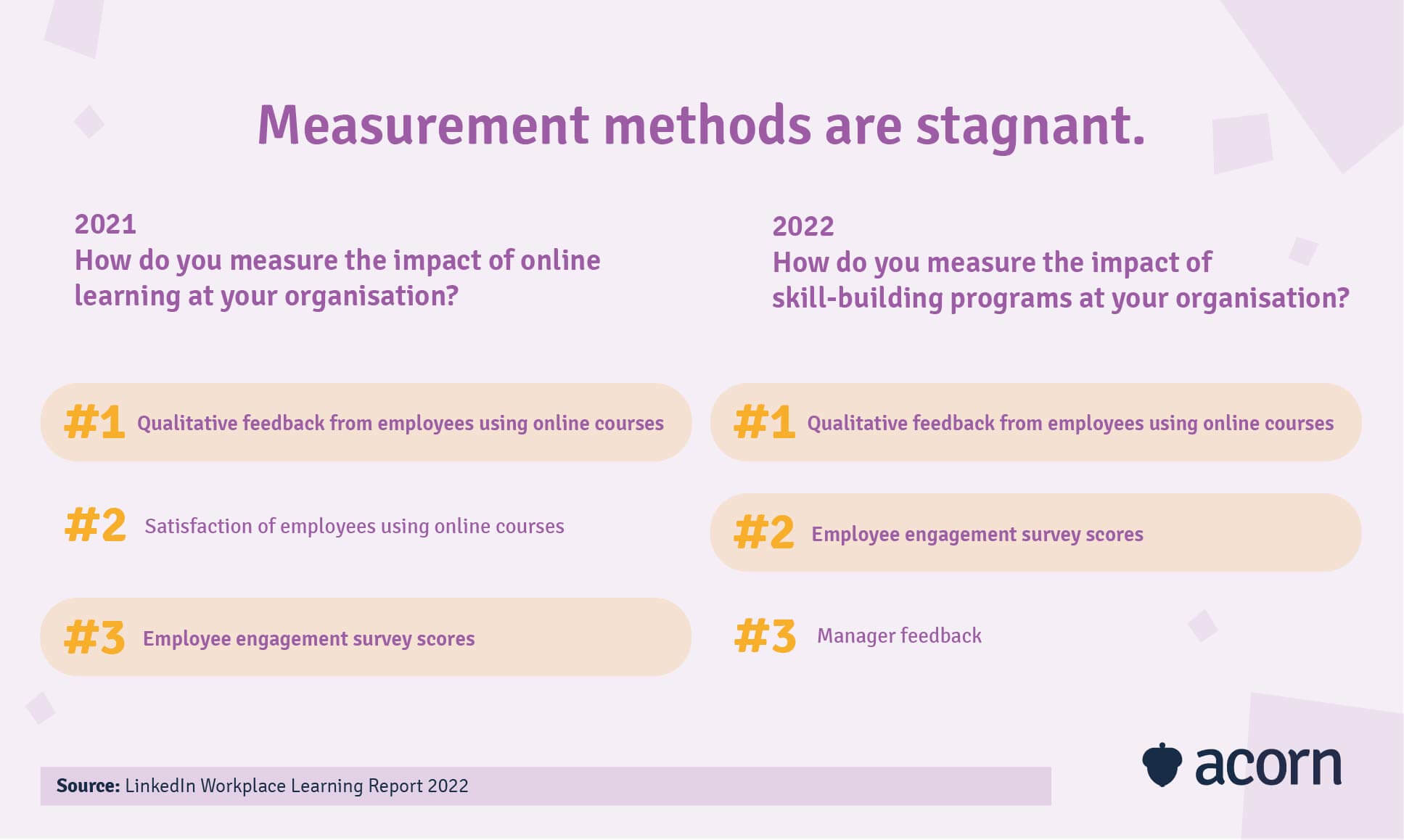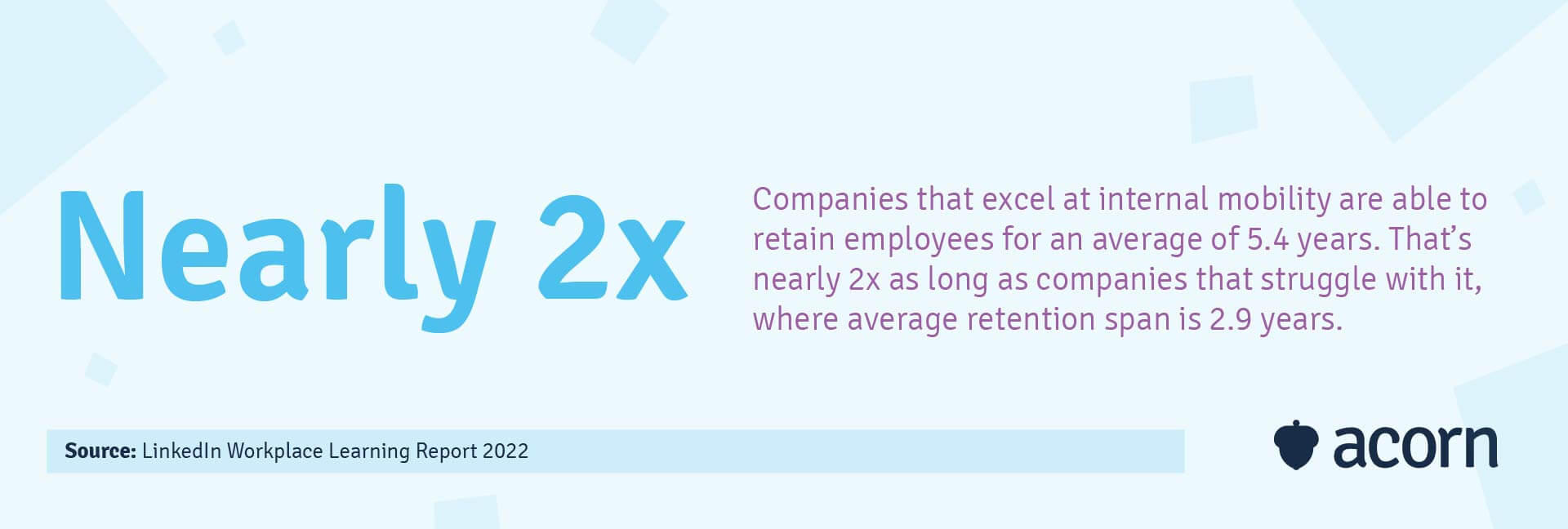Effective Strategies to Improve Transfer of Learning in the Workplace
Reading Time:

Lead the pack with the latest in strategic L&D every month— straight to your inbox.
SubscribeTangible transfer of learning comes down to the strength of your training content, learning culture, and training evaluation.
Transfer of learning is basically the learning outcome to worry about in the workplace. Without a measurable impact from past learning activities, there’s essentially nothing to show from supposedly strategic learning and development programs.
Getting learning transfer right comes down to the support systems you have in the workplace. It’s as much about post-training enablement as it is getting training right.
Read on to discover how you can create a culture of learning that ensures you’re consistently hitting those transfer of learning KPIs.
What is meant by transfer of learning?
Transfer of learning refers to the application of previously acquired knowledge, information and skills in a new setting or context.
In the workplace, this is both a key metric of strategic L&D and a way to evaluate the efficacy of your learning activities.
Why is transfer of learning important in the workplace?
The sum of all L&D endeavours comes down to business value, impact and ROI. Negative transfer of learning shows something lacking on all three of those fronts, and that L&D aren’t going to be able to justify spending.
Definitively proving value, impact and ROI comes down to these little things called KPIs. And since learning transfer lives in the sweet spot between learning impact and performance change, it’s an important bridge between employee performance and business outcomes.
But it’s the employee element of that equation that is the wild card. There are many scenarios in which zero transfer of learning happens; lack of post-training support and poorly-timed learning interventions, for starters.
The impacts of those scenarios aren’t the kind you want. Instead:
- Learning activities are prioritised reactively by performance issues rather than proactively by business impact, meaning only short-term benefits are felt.
- Your learning culture suffers as employees fail to experience long-term benefits of L&D.
- KPIs may not even be relevant or within reach, given poor ability to apply previous learning.
- Productivity is sidelined by lacking knowledge, skills and efficiency.
Ensuring knowledge transfer is part of the reason we created the performance learning management system (PLMS). Acorn PLMS does this in a couple of ways; first, it guides learners step by step to master the capabilities of their job roles to drive organisational performance. Second, the system captures key interactions happening within the workplace and transforms them into shareable learning assets to promote knowledge at scale. End to end, you’re codifying and operationalising capabilities the way they way they need to be used for optimal performance in your organisation.
Why transfer of learning occurs less than expected
There are a few pitfalls to avoid when aiming to hit that transfer of learning KPI.
- Poor training design. Even if content is tailored to job roles or capability gaps, disengaging delivery (think pages on pages of dry reading) will only cause employees to complete training just to check a box rather than applying new knowledge in the learning context.
- Unclear levels of competency. Essentially, what do employees currently know, and how far behind is that from where they need to be? Throwing learners into training that’s too many levels above their current capability will only cause unnecessary stress and block effective knowledge retention.
- Lack of workplace support. Supplementary resources, centralised knowledge systems, leadership buy-in, peer encouragement, and relevant projects all make or break skills application. (Words to live by: Training won’t do the job on its own.)
- No measurement. Without adequate metrics to measure how knowledge gained translates to performance change, you’ll likely be relying on subjective feedback. And that’ll do little to show the CEO that L&D even understands the needs of the business.

How can you ensure positive transfer of learning in the workplace?
First things first, there are some key tenets of learning to understand.
- New knowledge and skills take time to apply
- Learning is largely a social process
- Most training transfer occurs informally in the workplace.
That gives you some parameters for creating an L&D strategy that ensures transfer of learning.
Contextual training
A big part of creating a mature learning culture is providing training that is contextual to the business and employee needs. One instance in which negative transfer occurs is when training comes at the wrong time. Making training timely to the current pain points of a job role will go a long way to ensuring new information survives in working memory.
You can break this down in a few ways.
- By job role. Training programs are designed to develop specialist capabilities.
- By personal need. Capability assessments can flag individual capability gaps for development.
- By business priority. Heatmapping gives you an idea of which capabilities are at risk of extinction, and therefore in need of development.
From there, it’s a matter of using modes of training that make learning sticky. Consider the gap between learning activities and transfer tasks (i.e. the corresponding application of learned information).

On the job training, as an example, helps lessen the time between learning and application by putting learning in the context in which it will be applied.
Post-training enablement
Essentially, we’re talking about the support systems you have in place in the post-learning environment. You can only do so much in the learning situation itself (especially since many many employees may not think about new knowledge beyond the learning environment) before you have to focus on how a learner will apply knowledge.
Some strategies to implement here include:
- Microlearning courses that can be accessed in the moment of need
- Centralised knowledge systems like learning management systems
- Stretch assignments that directly reflect training programs
- Shared learning experiences, such as lunch and learns.
On that last point, a culture of continuous learning is key to learning transfer. Learning culture looks different even amongst teams within your organisation, but the overarching attitude towards learning remains a top-down issue.
Consider the phase in which learning may exist in your organisation.
- Reactive or incidental with unpredictable results
- Repeatable for process control
- ROI-focused through learning technology
- Based on demand forecasting for competitive advantage.
These are all status quos and directions that executives set for L&D. At the uppermost level of maturity, L&D helps architect a business for change while at the lowest level, it’s merely a vessel to occasionally impart job knowledge.
The latter is important, but it won’t move the needle on any of those larger business goals that employee training is meant to affect.
Ongoing review
If there’s any point we want to hammer home, it’s that you need to be continually analysing the entire learning lifecycle. That’s:
- Prior knowledge, skills and behaviours
- Initial learning activities undertaken
- The transfer context (i.e. where and how employees will apply learnings)
- Methods of performance evaluation.
Just as transfer of learning is itself an L&D KPI, look to the KPIs set for job roles. These are going to be the best way to understand if learning is a) relevant to the outcomes and b) those outcomes are achievable or aggressive.
This is generally where a stable structure for performance, like capabilities, will serve you best. It also means you can definitively show ROI and impact because learning outcomes can be tied directly to business outcomes.
We recommend borrowing from the Kirkpatrick training evaluation model, and focusing on performance improvements that happened only because of training. Utilise learning metrics such as competencies, performance indicators and progression rates to better understand business outcomes like employee engagement, process improvements and team effectiveness.
Key takeaways
You don’t need to get caught up in all the academic takes on near transfer, neutral transfer, positive transfer and zero transfer here. Transfer of learning is really just a matter of how to bridge the gap between newly learned information and application of said information in the workplace.
However, you do need to concern yourself with the ways in which complex skills, business processes and critical attributes are taught to employees, as well as how you nurture those capabilities in the flow of work.
If all else fails, three core principles will help you ensure impactful transfer of learning.
- Training needs to be relevant to real pain points, whether that’s to individual capability gaps or business weaknesses.
- Post-training enablement in the workplace matters just as much as training itself. Embed learning activities and resources in the day to day.
- Keep evaluating the strength of your L&D practices. KPIs and capabilities are your best weapon here.